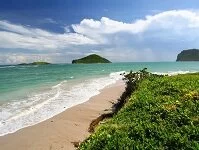Wildlife

Coast
St. Lucia has an odd wildlife system as the island nation has few indigenous mammals due to its volcanic origin; nearly every mammal you see was brought to the island by people. Off the island's shore though there are some native mammals including the whale and dolphins. More than the mammals though, these seas are teaming with fish and other sea life from larger animals like sharks and barracudas to smaller animals including eels, angelfish, grouper, sponges, lobsters, snapper, crabs, and thousands more including coral.
Like the sea life, there are plenty of birds that live on the island or migrate through. These birds are mostly limited to water fowls like ducks and egrets, but there are other non-water fowl species that call the island home, most notably the parrot. Many of the birds on St. Lucia can be found nowhere else on earth and this is the same for the reptilian life. However, its uniqueness, the reptilian and amphibian life is limited in numbers, but there are turtles, snakes, iguanas, and frogs among others. There are numerous other species, including insects.